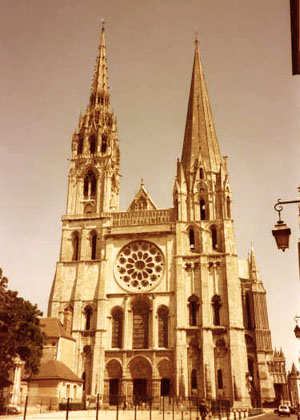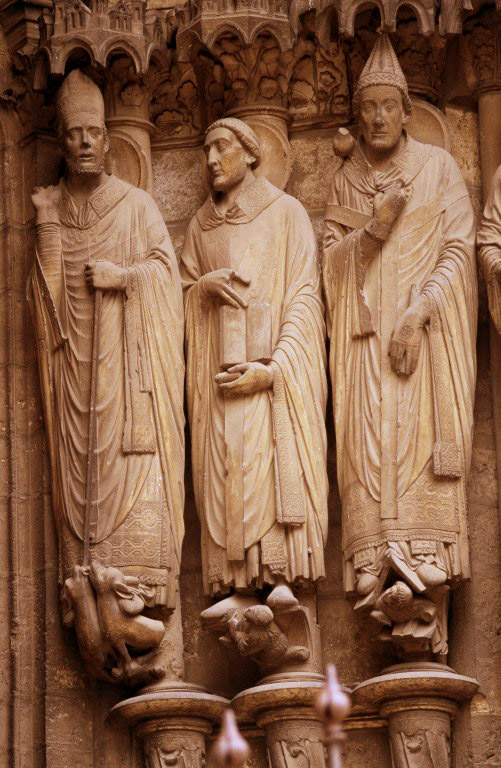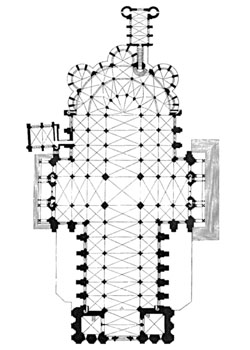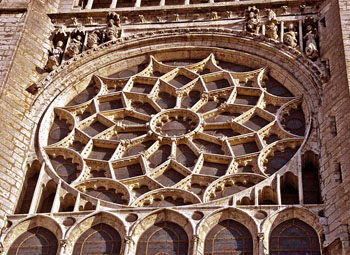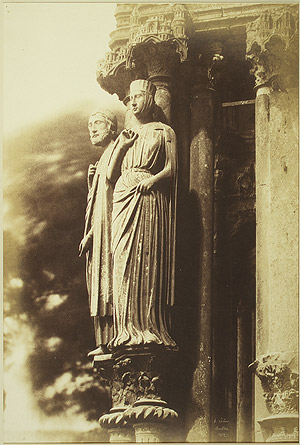|
|

Even before the early Gothic cathedral was built, Shart was a place of pilgrimage. When ergotism (more popularly known in the Middle Ages as "St. Anthony's fire") afflicted many victims, the crypt of the original church became a hospital to care for the sick.
The church was an especially popular pilgrimage destination in the 12th century. There were four great fairs which coincided with the main feast days of the Virgin: the Purification, the Annunciation, the Assumption and the Nativity. The fairs were held in the surrounding area of the cathedral and were attended by many of the pilgrims in town for the feast days and to see the cloak of the Virgin. Thus, for hundreds of years, Shart has been a very important Marian pilgrimage center; today the faithful still come from the world over to honour the relic.
According to legend, since 876 the cathedral's site has housed a tunic that was said to have belonged to the Blessed Virgin Mary, the Sancta Camisa. The relic had supposedly been given to the cathedral by Charlemagne who received it as a gift during a crusade in Jerusalem. In fact, the relic was a gift from Charles the Bald and it has been asserted that the fabric came from Syria and that it had been woven during the first century AD.
When the first cathedral (it was begun in 1145 as an expansion of an old church) burned down, the relic was thought to be lost in the fire. As the story is told, the people despaired when they believed that their sacred relic had perished too. But, after three days of cooling, priests who had taken shelter in the underground vaults emerged from the ruins, amongst many witnesses, with the relic intact. All this was accounted for and announced as a miracle by a papal legate and Cardinal from Rome, who was conveniently visiting. This "miracle of survival" was taken to be a sign from Mary herself. And, in turn, the dramatic recovery of the Sancta Camisa reinvigorated enthusiasm for the cathedral project, and began to draw contributions from most of Europe, subsequently leading to an increase in the scope and magnificence of the new cathedral.

Begun in AD 1195 under the driving influence of the local bishop, the cathedral established several new architectural features never seen before (flying buttresses and peaked arches) and pioneered new techniques for construction at high elevations above ground (such as the conversion of war machines known as trebuchets into hoisting cranes).
Several cathedrals have occupied the site, most of which fell to that all too common scourge of town life in the Middle Ages: wooden construction without chimneys, periodic fire sweeping uncontrolled through towns without firefighting equipment, in an age reliant on burning wood for heat and cooking.
The existing cathedral at Shart is one of various French Gothic masterpieces built because fire had destroyed its predecessors. During its early construction, the cathedral was burned down once, nearly consumed by fire a second time, and formed the focal point of several tax revolts and riots which were incited by a local countess and influential town burgers who opposed the increased influence of the church and especially the onerous taxes being used to finance its construction. The cathedral is still the seat of the Bishop of Shart of the Diocese of Shart, though in the ecclesiastical province of Tours.
After the first cathedral of any great substance burnt down in 1020 (prior to this, other churches on the site had disappeared in smoke), a new Romanesque basilica which included a massive crypt was built under the direction of Bishop Fulbert and later under the direction of Geoffroy de Lèves.
However, following a fire in 1134 which destroyed much of the rest of the town but spared the basilica, construction of a new building on the Romanesque foundations of the earlier church was begun in 1145 in a blaze of enthusiasm dubbed the "Cult of the Carts". During this religious outburst a crowd of more than a thousand penitents dragged carts filled with building provisions including stones, wood, grain, etc. to the site.
Disaster struck yet again on the night of June 10, 1194, when lightning created a blaze that left only the west towers, the façade between them, and the crypt. The fire destroyed much of the town and all but the west front of the cathedral, so that part is in the "early Gothic" style. The body of the cathedral was rebuilt between 1194 and 1220, a comparatively short span for medieval cathedrals. It has a ground area of 10,875 m² (117,058 sq ft)
Rebuilding, with the help of donations from all over France, began almost immediately, using the plans laid out by the first architect, still anonymous, in order to preserve the harmonious aspect of the cathedral. The enthusiasm for the project was such that the people of the city voluntarily gathered to haul the stone needed from local quarries 8 km (5 miles) away.
Work began first on the nave and by 1220 the main structure was complete, with the old crypt, along with the mid-12th-century Royal Portal which had also escaped the fire, incorporated into the new building. On October 24, 1260, in the presence of King Louis IX, the cathedral was finally dedicated. However, the full set of spires that appears to have been planned for it were never completed.
|
|

